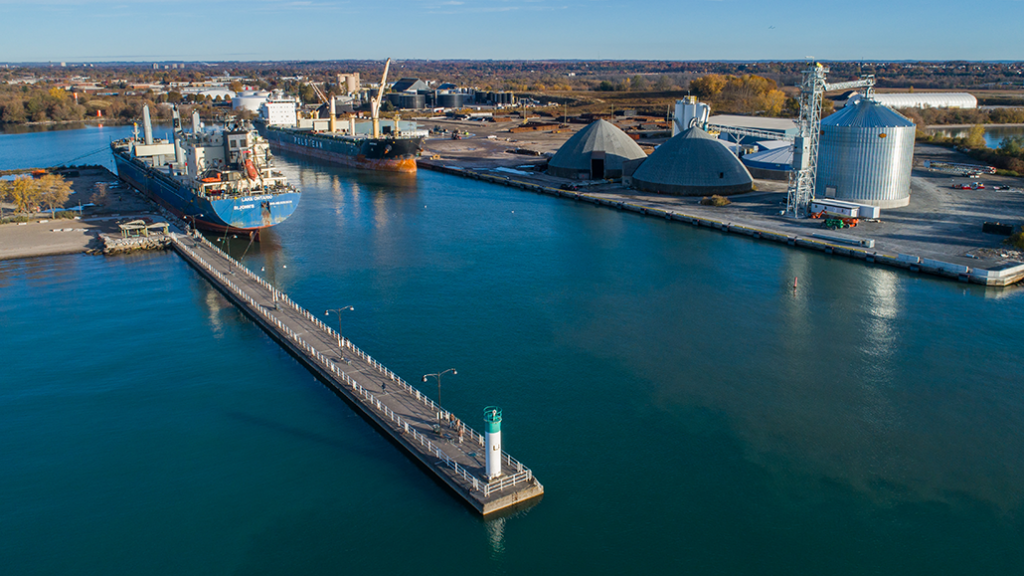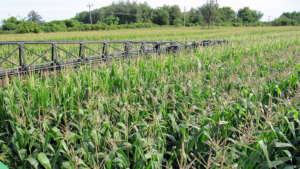Port of Oshawa expansion
IMPROVING GRAIN EXPORT CAPACITY

IN JUNE OF this year, the federal government committed close to $14 million to an export expansion project at the Port of Oshawa. The recipient, the Hamilton-Oshawa Port Authority, will contribute $16 million to the project, bringing the total investment to nearly $30 million. The funds awarded through the National Trade Corridors Fund will be used to build new infrastructure to modernize the operation, positioning it for considerable growth.
This is good news for producers, particularly those who live in counties east of the Greater Toronto and Hamilton Area (GTHA), as they will no longer have to cart grain across North America’s busiest highway, the 401. The upgrade means they will be able to deliver quickly and efficiently closer to home. Currently, producers have limited access in terms of port facilities. They can travel east and deliver to the Port of Johnstown on the St. Lawrence Seaway system or drive across the GTHA to Hamilton, where there are three export terminals and an oilseed crush facility.
“That’s not an ideal situation for any number of stakeholders,” says Larissa Fenn, director of public affairs, Hamilton-Oshawa Port Authority (HOPA). “For producers themselves, it’s a long trip, it takes a long time, and it reduces the number of trips you can make in a day. And, obviously, the truck traffic affects the travelling public in the Greater Toronto area.”
While the Port of Oshawa has some grain storage and export capacity, efficiency and speed have been issues for producers using the port, explains Fenn. As it stands now, the port has storage capacity for 10,000 MT, which means a great deal of direct loading that is subject to stoppage due to inclement weather. The upgrade will double that capacity to 20,000 MT.
INCREASING EFFICIENCY AND CAPACITY
More importantly, the upgrade will greatly improve the port’s efficiency and capacity. Once completed, the Port of Oshawa will have access and egress via a full internal ring road, and trucks will be able to get in, unload, and exit the port safely and efficiently.
“Storage capacity is one part of the equation, but really unloading and then the internal ring road to improve the fluidity of truck traffic within the port is just as much of an improvement,” says Fenn. “I think grain farmers who have been in the port before will recognize that part of the challenge with that facility was the getting in and out.”
The upgrade will equip the port with new unloading pits that should increase the unloading speed of a truck. Currently, they use an extensive hopper and conveyor system to fill an entire vessel. The system is finicky, as both the conveyor system and the vessel need to be moved back and forth to create a balanced load.
“In some cases in the past, the vessels have had to leave with less than a full load because of the time it took to load at the Port of Oshawa,” says Fenn.
The new system will improve the interaction between the conveyor and the vessel, shortening the entire loading process.
“We are happy that the issue of not being able to load to capacity will be overcome,” she says.
HOPA expects the new port facilities to take about 12,000 trips off the 401 Highway each year, which is good news for anyone who regularly uses the notoriously busy highway. Additionally, it will be able to handle up to 300,000 MT each year once complete.
According to HOPA research, production, yields and global demand are all expected to rise, making the project even more timely.
“Location-wise, Oshawa is a really key hub for grain exports in the Greater Toronto-Hamilton Area,” says Fenn. “It will enable producers potentially to make more than one drop-off a day and help to increase the overall grain exports from Ontario. We expect to serve farmers handling corn, wheat, and soybeans in about a 100-kilometre radius, so certainly Durham farmers and beyond.”
Grain Farmers of Ontario reports that producers within the Port of Oshawa’s catchment area grew over 1.1 million metric tonnes of corn, over 450,000 metric tonnes of soybeans, and over 320,000 metric tonnes of wheat in 2021.
A WELCOME INVESTMENT
Dana Dickerson, manager of market development at Grain Farmers of Ontario, welcomes the investment. “We really welcome seeing infrastructure upgrades, seeing wait times reduced for farmers, and seeing more marketing options available for farmers to increase the diversification of the opportunities for them to sell their grains,” she says.
“It’s really good to see the federal government investing in Ontario, in our infrastructure,” she adds. “With everything that’s going on in the world right now, it’s really important that trade is moving fluidly and that we can get our exports in the water and move more grain to the places that need it.”
The investment is the first since the amalgamation of the Hamilton-Oshawa Port Authority. Fenn says it highlights the value of an integrated port network and seeing the GTHA as an economic region considered as a whole.
“I think it’s just an illustration of that integrated port network model working really well, as it’s supposed to,” she says.
Pre-construction design work for the Port of Oshawa project is underway; construction should begin this fall. HOPA expects the project completion in three to four years. •

























